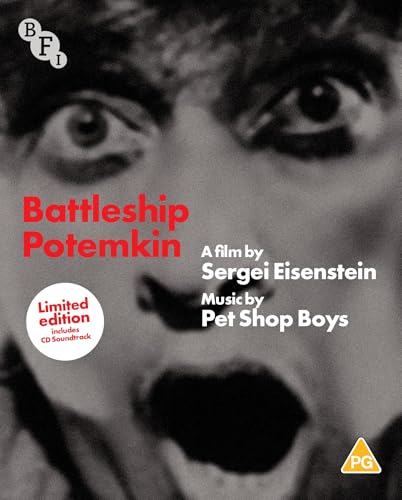 Battleship Potemkin / Pet Shop Boys Score (Limited Edition Blu-ray & CD) | Blu Ray | (05/09/2025)
from £19.99
| Saving you £N/A (N/A%)
| RRP
Battleship Potemkin / Pet Shop Boys Score (Limited Edition Blu-ray & CD) | Blu Ray | (05/09/2025)
from £19.99
| Saving you £N/A (N/A%)
| RRP A fixture in the critical canon almost since its premiere, Sergei Eisenstein's legendary film about a 1905 naval mutiny was revolutionary in both form and content. Battleship Potemkin is celebrated for its dynamic compositional strength and editing of such frame-perfect precision that it's hard not to be swept along. Despite endless quotation and parody, the set-piece massacre on the Odessa Steps still packs a sledgehammer punch.First revealed at a special outdoor screening in front of an estimated 25,000 in Trafalgar Square in 2004, Pet Shop Boys' score, performed with the Dresdner Sinfoniker and orchestrated by Torsten Rasch, blends electronic beats with orchestral grandeur to create a contemporary cinematic experience.Extras· Hochhaussinfonie (2017, 68 mins): a multimedia musical production by the Dresdner Sinfoniker orchestra and Pet Shop Boys, conceived by Markus Rindt and directed by Sven Helbig, on the evening of 20 July 2006, in Dresden· Trafalgar Square Highlights (2004, 4 mins): a behind-the-scenes film when Pet Shop Boys performed their newly composed score for Battleship Potemkin, accompanied by the Dresdner Sinfoniker orchestra in Trafalgar Square, London· CD featuring the score by Pet Shop Boys and Dresdner Sinfoniker· Trailer (2025)· **LIMITED EDITION** Illustrated booklet featuring new writing by Chris Heath and Sarah Cleary, and archive pieces by Neil Tennant and Michael Brooke· First time the film has been available with the Pet Shop Boys score· Pet Shop Boys have a devoted fanbase across the globe· Battleship Potemkin is still regarded as a must-have disc in any serious film collection· 2025 is the centenary of Battleship Potemkin
![Eisenstein Collection Vol.1 [1925]](/pictures/1068721.jpg) Eisenstein Collection Vol.1 | DVD | (13/08/2007)
from £N/A
| Saving you £N/A (N/A%)
| RRP
Eisenstein Collection Vol.1 | DVD | (13/08/2007)
from £N/A
| Saving you £N/A (N/A%)
| RRP Strike (1925): In 1922 Lenin also had said that ""...of all of the arts for us the cinema was the most important."" In 1924 the Proletkult offered Eisenstein then 26 years of age the job of directing the first of eight episodes in the film series 'Towards the Dictatorship'. This brilliant and complex re-creation of the development of a 1912 factory strike in Tsarist Russia and its savage destruction by agents provocateurs police and mounted troops was an ideal vehicle for the youthful Eisenstein to express his desire to reflect the dialectic of the Russian revolution in the most comprehensive of art forms. Eisenstein had been developing the Kuloshov's 'montage' effect in editing and in this his first film he uses it with tremendous skill to enhance symbolism and achieve highly charged emotional responses to the strength energy and heroism of the working classes and the tragic events depicted. Strike is a truly visual and technical masterpiece which is at times overwhelming in its powerful portrayal of these events in history. Strike was the only film ever made in the series and it changed the direction of the soviet cinema for many decades to come. Battleship Potemkin (1925): Planned by the Soviet Central Committee to coincide with the celebrations for the 20th anniversary of the unsuccessful 1905 Russian Revolution this film was developed by the 27 year-old Sergei Eisenstein from less than one page of script from a planned eight-part epic that was intended to chronicle a large number of revolutionary actions. Starting with the Potemkin's crew's refusal to eat maggot-infested meat the mutiny develops and their leader Vakulinchuk is shot by a senior officer. The officers are overthrown and when the Potemkin docks at Odessa crowds appear from all directions to take up the cause of the dead sailor and open rebellion ensues. What became the Czarist soldiers fire on the crowds thronging down the Odessa steps: the broad newsreel-like sequences being inter-cut with close-ups of harrowing details. Returning to sea the Potemkin's crew prepares the guns for action as the ship flying the flag of freedom steams to confront the squadron. When they finally meet theirs worst fears are allayed as with relief coupled with joy they are universally acclaimed. This film which was destined to become such an influential landmark in cinematographic history opened in Moscow in January 1926. It ran for only four weeks. October (1927): Commissioned by the October Revolution Jubilee Committee (Chairman Nikolai Podvolsky) for the tenth anniversary of the revolution Sergei Eisenstein's third major feature film ""October 1917"" is a marvelous reconstruction of the events from February leading up to the revolution and the Bolshevik's overthrow of the czarists and Kerensky's provisional government in 1917. True to the communist philosophy there were no main characters; the proletariat providing the 'heroic' star quality throughout. The ultimate victory belonging to the revolution. Eisenstein's skill and experimentation in using fast moving and rhythmic montage to produce telling metaphors and build and intensify sequences was not fully understood by the early Russian audiences; typical examples being the rapidly alternating images employed to create a machine-gun firing and the cross-cutting between power-hungry Kerensky and the statue of Napoleon. Outstanding for the period are the dynamic sequences illustrating the massacre in the vicinity of the St Petersburg bridges and the storming of the Winter Palace which feature a profusion of exciting cinematic techniques. Eisenstein's research was extremely thorough and he did not allow contemporary events to influence his production. The film's release was dela
![Battleship Potemkin [1925]](/pictures/1006432.jpg) Battleship Potemkin | DVD | (17/04/2000)
from £8.98
| Saving you £13.00 (185.98%)
| RRP
Battleship Potemkin | DVD | (17/04/2000)
from £8.98
| Saving you £13.00 (185.98%)
| RRP Sergei Eisenstein's revolutionary sophomore feature has so long stood as a textbook example of montage editing that many have forgotten what an invigoratingly cinematic experience he created. A 20th-anniversary tribute to the 1905 revolution, Eisenstein portrays the revolt in microcosm with a dramatisation of the real-life mutiny aboard the battleship Potemkin. The story tells a familiar party-line message of the oppressed working class (in this case the enlisted sailors) banding together to overthrow their oppressors (the ship's officers), led by proto-revolutionary Vakulinchuk. When he dies in the shipboard struggle the crew lays his body to rest on the pier, a moody, moving scene where the citizens of Odessa slowly emerge from the fog to pay their respects. As the crowd grows Eisenstein turns the tenor from mourning a fallen comrade to celebrating the collective achievement. The government responds by sending soldiers and ships to deal with the mutinous crew and the supportive townspeople, which climaxes in the justly famous (and often imitated and parodied) Odessa Steps massacre. Eisenstein edits carefully orchestrated motions within the frame to create broad swaths of movement, shots of varying length to build the rhythm, close-ups for perspective and shock effect, and symbolic imagery for commentary, all to create one of the most cinematically exciting sequences in film history. Eisenstein's film is Marxist propaganda to be sure but the power of this masterpiece lies not in its preaching but its poetry. --Sean Axmaker
 The Cuckoo | DVD | (13/09/2004)
from £N/A
| Saving you £N/A (N/A%)
| RRP
The Cuckoo | DVD | (13/09/2004)
from £N/A
| Saving you £N/A (N/A%)
| RRP Following his escape from his Nazi captors a Finnish sniper struggles through no-man's-land as he attempt to find the required tools to remove his heavy shackles. He happens upon a farm where a war widow is tending a wounded deserter from the Red Army...
![Strike [1924]](/pictures/1006374.jpg) Strike | DVD | (17/07/2000)
from £19.65
| Saving you £0.34 (1.73%)
| RRP
Strike | DVD | (17/07/2000)
from £19.65
| Saving you £0.34 (1.73%)
| RRP Sergei Eisenstein's debut film is more than a landmark of Soviet cinema; it's easily one of the most thrilling and inventive films to emerge from the silent era of Russian film making. Eisenstein was a theatre director and stage designer with some very specific ideas about the cinema, and he put them into practice telling the story of a worker's strike in pre-Revolution Russia, portraying the struggle not of leader against leader, but of the proletariat against the factory owners, enlivened by a conspiratorial subplot involving a quartet of insidious spies sent to infiltrate the ranks of the workers. The subject matter is at times didactic and the acting often hammy and overwrought, but the technique is vibrant and the images striking. Eisenstein's compositions reflect the graphic boldness of contemporary poster art, mixing poetic realism with grotesque expressionism in a gripping style, and his famous montage editing style (to be perfected in his next film, Battleship Potemkin) is raw, experimental and energetic. Eisenstein's later films are more consistent and elegant, but none of them have the sheer cinematic invention and energy of this first film. The new score, composed and performed by the idiosyncratic Alloy Orchestra, combines a mix of martial and mood music on synthesiser with the driving percussion of drums, wood blocks, bells and wrecking yard of clanging metal objects--a dynamic soundtrack to one of the most auspicious directoral debuts ever. --Sean Axmaker
![Battleship Potemkin [Blu-ray] [1925] [US Import]](/pictures/1152407.jpg) Battleship Potemkin | Blu Ray | (20/04/2010)
from £N/A
| Saving you £N/A (N/A%)
| RRP
Battleship Potemkin | Blu Ray | (20/04/2010)
from £N/A
| Saving you £N/A (N/A%)
| RRP 
Please wait. Loading...
This site uses cookies.
More details in our privacy policy